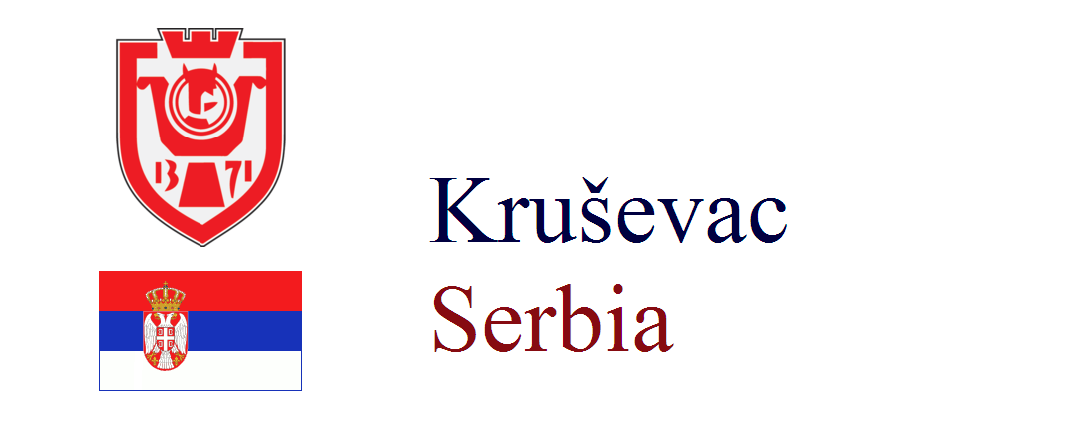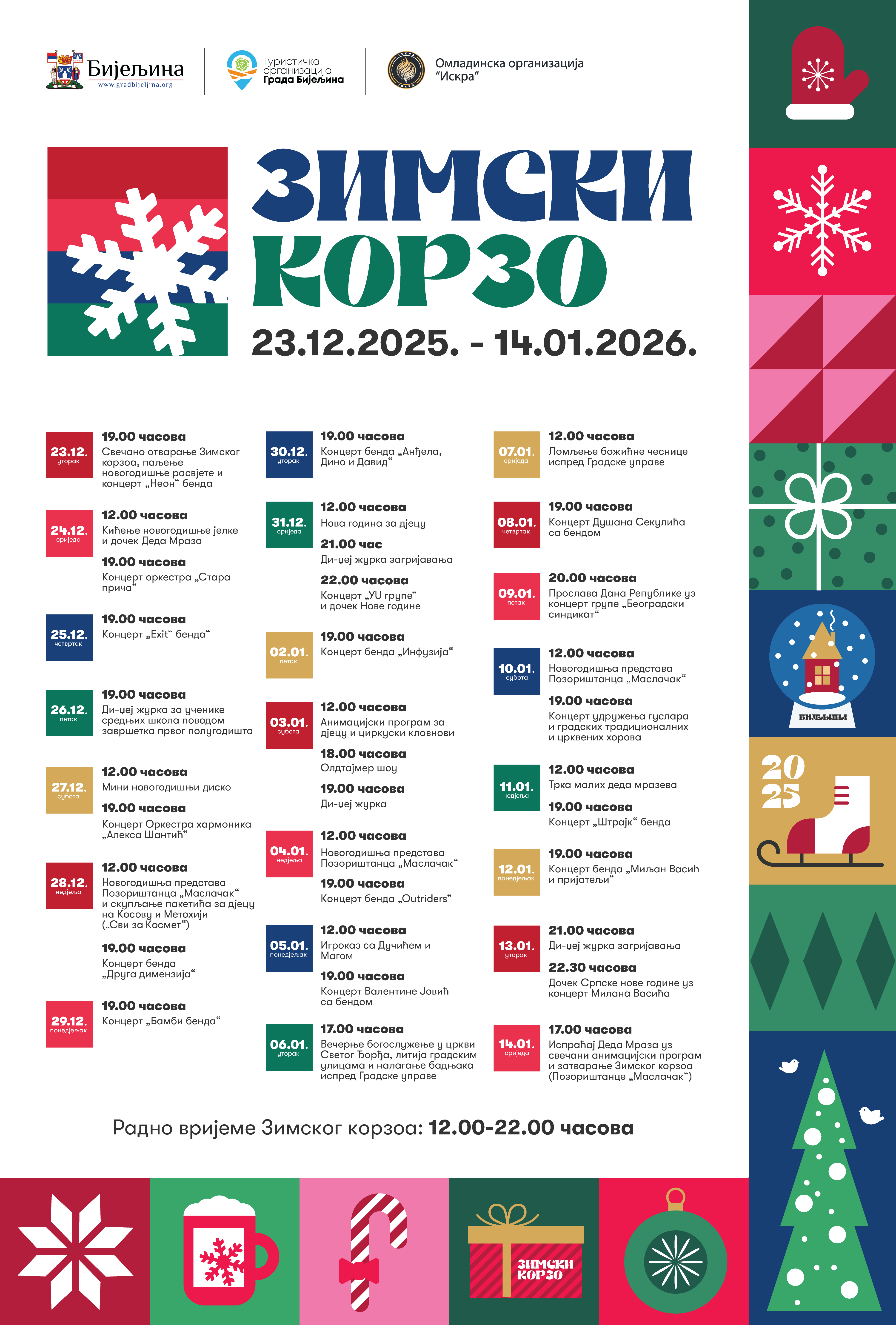Kruševac (Serbia)

Kruševac is a city in the Rasina District in Central Serbia, and an administrative, economic, cultural, health, and educational centre of the District. It is located in the Kruševac valley which includes composite valley of West Morava between Levče and Temnić in the north, Župa, Kopaonik and Jastrebac in the south, and Kraljevo valley and Ibar valley in the west.
According to the census of 2011, there are around 59,000 inhabitants in the urban area, and more than 131,000 inhabitants in the whole territory of the city.
Twinning agreement between Kruševac and Bijeljina was signed in 2008.
HISTORY
Kruševac was founded by Prince Lazar in 1371, as his capital. It was mentioned in 1387 for the first time, in the charter by which Prince Lazar, in his fortified capital, confirmed earlier trade privileges to Dubrovnik.
The legend says that Kruševac was named after the round river stone krušac, which was used to build most of the city. After the Battle of Kosovo, Kruševac became the capital of vassal Serbia ruled by Princess Milica, and then Despot Stefan who moved the capital to Belgrade. The Turks conquered Kruševac in 1427, after the death of Despot Stefan. From 1444, Kruševac was ruled by Đurađ Branković, but the Turks finally conquered it in 1454 and named it Alaca Hisar (colourful city). During 17th and 18th centuries, Kruševac was liberated several times from the Turkish rule, but only for short periods. During the First Serbian Uprising, the city was liberated in 1806 and remained free until 1809. The nickname Čarapani (čarapa = sock) originates from that time, and people from Kruševac are proud of this name even today. The nickname was coined in 1806 after one attack on the Turks when people of Kruševac demonstrated great heroism and cunningness by taking off their shoes and snuck up on the Turks and killed them while wearing socks on their feet.
Kruševac was finally liberated from the Turks in 1833. After the liberation the city rapidly developed and prospered, and it became one of the biggest regional centres of Serbia at the time. During the First World War the city was largely destroyed, and the inhabitants experienced severe terror. During the Second World War, German occupiers shot 1642 patriots from Kruševac and surroundings on the hill called Bagdala.
ECONOMY
Kruševac is an important economic centre with developed metal processing (14. oktobar) and chemical industry (HI Župa, Henkel-Merima, Trayal).
Factory of alcoholic and non-alcoholic beverages Rubin, and lubricant factory FAM are also located in Kruševac.
The famous spa centre Ribarska Banja is located near Kruševac.
CULTURAL AND HISTORICAL SIGHTS
Kruševac is famous for the Lazarica Church, the endowment of Prince Lazar, remains of Lazar’s city with the Donjon Tower and monuments of Kosovo heroes and Prince Lazar. Saint Roman Monastery (with the remains of Saint Roman) is located near the city, and the monastery is famous because the heart of Russian nobleman Nikolai Nikolaevich Rajewski was buried in the church yard. He was the inspiration for Tolstoy’s character Vronsky in his novel Anna Karenina. There is also the Monastery of the Intercession of the Theotokos in the village of Đunis, and the Naupara Monastery, endowment of Despot Stefan Lazarević, according to the legend.
CULTURE
In addition to the Kruševac Theatre, several choirs and cultural-art associations, Kruševac hosts a number of cultural events.
The most important events are:
- “Svetosavska nedelja” (Saint Sava’s Week),
- International festival of humour and satire “Zlatna kaciga” (Golden Helmet) (31 March – 1 April),
- International Children’s Art Colony “Biberče” (mid June),
- “Vidovdan” – Solemnities of freedom (23-28 June),
- Kruševac literary-philosophical school,
- Summer of culture (a number of theatre plays and cinema movies, classical, pop-rock and jazz music concerts, and various programmes of performers from Kruševac and other cities during summer, mainly on outdoor spaces and stages),
- Art colony “Dvorane” – in the ambient of villages of Dvorane, Petina and Lovci, near the Mika's watermill (July),
- “Belovodska rozeta” (Whitewater Rosette) (late June and early July) – gathers writers in the Literary School “Slovo ljubve”, artists in the sculpture colony “Belovodski peščar” and stonemasons within the programme cherishing the stonemason tradition of this area, called “Days of Rade Neimar”. The event involves actors, reciters, musicians, folk artists, within the art programme “Moravske vedrine”,
- Days of theatre (October) – festival of the most significant Serbian theatre plays,
- October exhibition – traditional annual exhibition of painters from Kruševac. Every other year it is preceded by a biennial exhibition of works of art by people of Kruševac – students of faculties and academies of fine and applied arts,
- New Year’s programme (December) – a number of cultural events (plays, concerts of classical, pop and rock music, children’s music festivals, opera plays).
The City Day is celebrated on Saint Vitus Day (Vidivdan) on 28 June.
Slava (patron saint’s day) of the City of Kruševac is Holy Trinity (Descent of the Holy Spirit, on Sunday, fifty days after Easter).
INTERNATIONAL COOPERATION
In addition to Bijeljina, Kruševac is a sister city / twin town of: Corfu (Greece), Szentendre (Hungary), Râmnicu Vâlcea (Romania), Pistoia (Italy), Kiryat Gat (Israel), Trogir (Croatia), and Travnik (BaH).
Kruševac has an intense cooperation with Volgograd (Russia), Ryazan (Russia), Stara Zagora (Bulgaria), and Žalec (Slovenia).
LINKS
https://krusevac.ls.gov.rs/
https://sr.wikipedia.org/sr/Kruševac
According to the census of 2011, there are around 59,000 inhabitants in the urban area, and more than 131,000 inhabitants in the whole territory of the city.
Twinning agreement between Kruševac and Bijeljina was signed in 2008.
HISTORY
Kruševac was founded by Prince Lazar in 1371, as his capital. It was mentioned in 1387 for the first time, in the charter by which Prince Lazar, in his fortified capital, confirmed earlier trade privileges to Dubrovnik.
The legend says that Kruševac was named after the round river stone krušac, which was used to build most of the city. After the Battle of Kosovo, Kruševac became the capital of vassal Serbia ruled by Princess Milica, and then Despot Stefan who moved the capital to Belgrade. The Turks conquered Kruševac in 1427, after the death of Despot Stefan. From 1444, Kruševac was ruled by Đurađ Branković, but the Turks finally conquered it in 1454 and named it Alaca Hisar (colourful city). During 17th and 18th centuries, Kruševac was liberated several times from the Turkish rule, but only for short periods. During the First Serbian Uprising, the city was liberated in 1806 and remained free until 1809. The nickname Čarapani (čarapa = sock) originates from that time, and people from Kruševac are proud of this name even today. The nickname was coined in 1806 after one attack on the Turks when people of Kruševac demonstrated great heroism and cunningness by taking off their shoes and snuck up on the Turks and killed them while wearing socks on their feet.
Kruševac was finally liberated from the Turks in 1833. After the liberation the city rapidly developed and prospered, and it became one of the biggest regional centres of Serbia at the time. During the First World War the city was largely destroyed, and the inhabitants experienced severe terror. During the Second World War, German occupiers shot 1642 patriots from Kruševac and surroundings on the hill called Bagdala.
ECONOMY
Kruševac is an important economic centre with developed metal processing (14. oktobar) and chemical industry (HI Župa, Henkel-Merima, Trayal).
Factory of alcoholic and non-alcoholic beverages Rubin, and lubricant factory FAM are also located in Kruševac.
The famous spa centre Ribarska Banja is located near Kruševac.
CULTURAL AND HISTORICAL SIGHTS
Kruševac is famous for the Lazarica Church, the endowment of Prince Lazar, remains of Lazar’s city with the Donjon Tower and monuments of Kosovo heroes and Prince Lazar. Saint Roman Monastery (with the remains of Saint Roman) is located near the city, and the monastery is famous because the heart of Russian nobleman Nikolai Nikolaevich Rajewski was buried in the church yard. He was the inspiration for Tolstoy’s character Vronsky in his novel Anna Karenina. There is also the Monastery of the Intercession of the Theotokos in the village of Đunis, and the Naupara Monastery, endowment of Despot Stefan Lazarević, according to the legend.
CULTURE
In addition to the Kruševac Theatre, several choirs and cultural-art associations, Kruševac hosts a number of cultural events.
The most important events are:
- “Svetosavska nedelja” (Saint Sava’s Week),
- International festival of humour and satire “Zlatna kaciga” (Golden Helmet) (31 March – 1 April),
- International Children’s Art Colony “Biberče” (mid June),
- “Vidovdan” – Solemnities of freedom (23-28 June),
- Kruševac literary-philosophical school,
- Summer of culture (a number of theatre plays and cinema movies, classical, pop-rock and jazz music concerts, and various programmes of performers from Kruševac and other cities during summer, mainly on outdoor spaces and stages),
- Art colony “Dvorane” – in the ambient of villages of Dvorane, Petina and Lovci, near the Mika's watermill (July),
- “Belovodska rozeta” (Whitewater Rosette) (late June and early July) – gathers writers in the Literary School “Slovo ljubve”, artists in the sculpture colony “Belovodski peščar” and stonemasons within the programme cherishing the stonemason tradition of this area, called “Days of Rade Neimar”. The event involves actors, reciters, musicians, folk artists, within the art programme “Moravske vedrine”,
- Days of theatre (October) – festival of the most significant Serbian theatre plays,
- October exhibition – traditional annual exhibition of painters from Kruševac. Every other year it is preceded by a biennial exhibition of works of art by people of Kruševac – students of faculties and academies of fine and applied arts,
- New Year’s programme (December) – a number of cultural events (plays, concerts of classical, pop and rock music, children’s music festivals, opera plays).
The City Day is celebrated on Saint Vitus Day (Vidivdan) on 28 June.
Slava (patron saint’s day) of the City of Kruševac is Holy Trinity (Descent of the Holy Spirit, on Sunday, fifty days after Easter).
INTERNATIONAL COOPERATION
In addition to Bijeljina, Kruševac is a sister city / twin town of: Corfu (Greece), Szentendre (Hungary), Râmnicu Vâlcea (Romania), Pistoia (Italy), Kiryat Gat (Israel), Trogir (Croatia), and Travnik (BaH).
Kruševac has an intense cooperation with Volgograd (Russia), Ryazan (Russia), Stara Zagora (Bulgaria), and Žalec (Slovenia).
LINKS
https://krusevac.ls.gov.rs/
https://sr.wikipedia.org/sr/Kruševac

